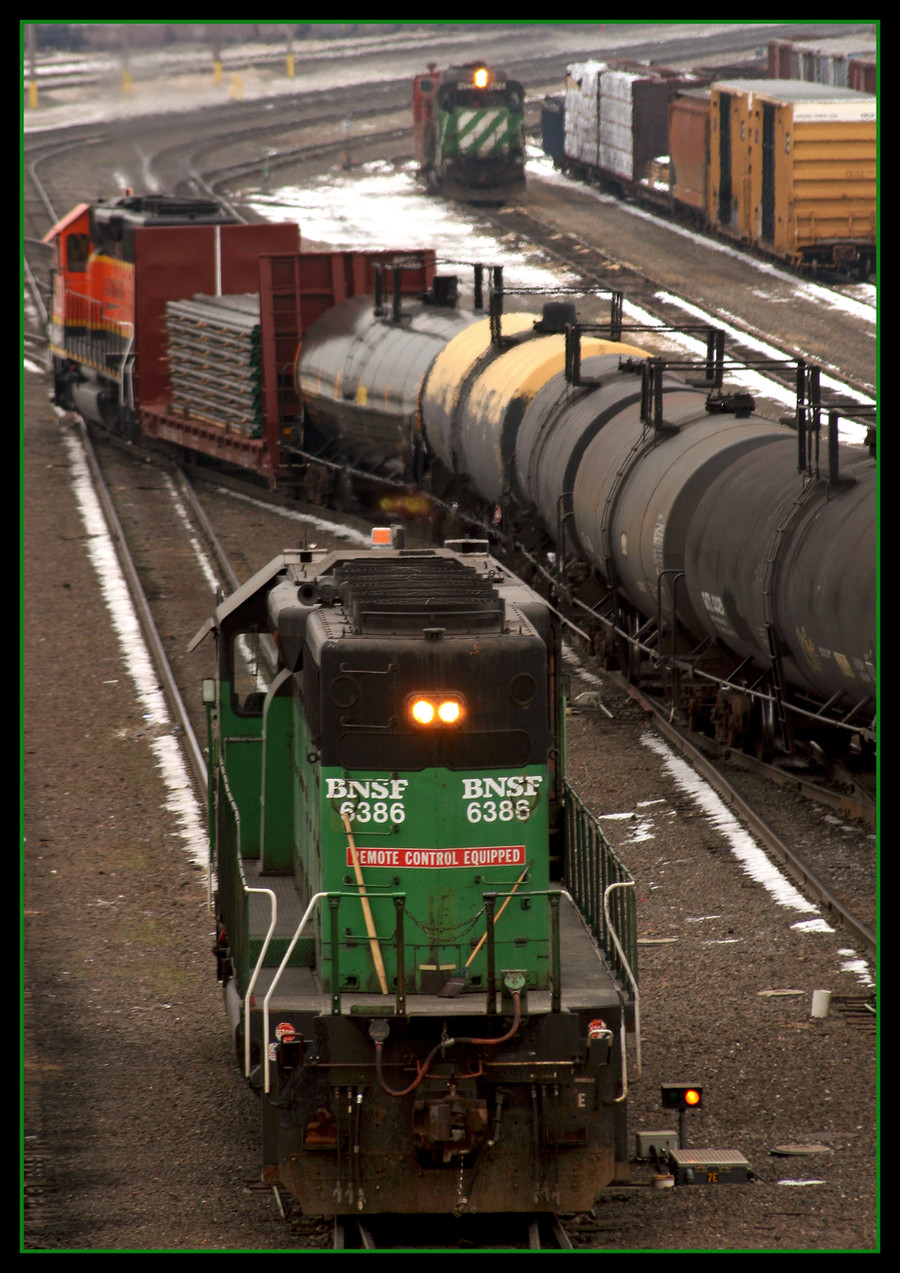HOME | DD
 factorone33 — Argentine: Trimmin'
factorone33 — Argentine: Trimmin'

Published: 2008-05-08 19:13:28 +0000 UTC; Views: 767; Favourites: 31; Downloads: 19
Redirect to original
Description
This is the final stage in building consists for departure. Here, BNSF SD40-2 #6915 backs into the bowl with a fairly large cut of cars, building a consist between the bowl and the trim tracks, while SD40-2 #6386 idles, waiting for #6915 to clear the track.Note the total absence of ditch lights.
Canon EOS 30D
Sigma 70-300mm f/4-5.6
ISO 200 @ 1/160, f/9
Related content
Comments: 18

What like no driver???? Your kidding... I can't believe it.
👍: 0 ⏩: 1

Well, yard personnel who operate these units are issued identical remote control packs (the engineers and conductors each get one), and they can operate them anywhere usually within a mile of the specific locomotive. You don't see them on mainline operation much, as they don't have a practical purpose in that setting, howerever, in a yard application, they are invaluable at times.
👍: 0 ⏩: 1

Thats is just awesome, yes i can imagine they are not used on the mainlines, but are used for just Yard work. Assuming they are slow but powerful?
👍: 0 ⏩: 1

They're not necessarily slow, as most of these units used to be mainline locomotives (they're technically called "road switchers"), but I would assume that BNSF has since re-geared them for better tractive effort in the yard.
👍: 0 ⏩: 1

Here, check this out --> [link]
That guy has one of the control packs I was referring to. From what I've seen, they're usually used in the dissection of incoming consists and for going over the hump in the process, but they're quite effective in the trim section for building outbound consists and trains. Two or three guys with remotes can effectively do the work of two 3-man crews
👍: 0 ⏩: 1

Thats amazing 

👍: 0 ⏩: 0

Awesome! You couldn't ask those trains to be in better spots.
👍: 0 ⏩: 1

Well, considering I was standing on top of a viaduct 30 feet above them, not really.
But yes, it was great positioning.
👍: 0 ⏩: 0

Especially on the trim jobs. I saw more traction on that end of the yard than anywhere else (not counting the stuff coming into the yard either). It seems that it's quicker to cut down a consist than it is to build one, but the hump accounts for that I guess.
👍: 0 ⏩: 1

You're right. Humps save a lot of switching time, but switching with the air brakes bled off saves the most time. In most small intermediate yards, all switching moves are made with air, which means the crew has to wait for the brakes to pump up after making every joint, and all cars cut off dump their air every time the engine pulls away.
👍: 0 ⏩: 1

So I take it they just use the locomotive break and dynamics then?
👍: 0 ⏩: 1

Well, safety is achieved by engineering the yard so that the ends of the tracks are higher than the centers, thus using gravity to keep the cars in the "bowl" where they belong. Deramus yard in Shreveport is a humpless bowl yard; so carmen bleed off inbound cars, and switch crews drag them up the lead and kick them into yard tracks to achieve a similar effect to humping. In order for a trim job to drag cars out of the bowl safely, the trim tracks must also be bowl'ed to keep the cars together. Once the trim jobs have built an outbound train and a hostler crew has coupled up the engine consist, the yardmaster electronically secures the switches at both ends of the track, carmen put up their blue flags hook up all the brake lines, perform a class 1 air test, and check that all cars in the consist are FRA compliant. Most of the time, bad order cars get noted at the hump, and therefore roll into a track set aside for bad orders. Trim jobs will then take the bad orders to the car shop for repair before humping them again.
👍: 0 ⏩: 1

So...to answer your question directly...the engines' independent brakes and dynamics are the only usable brakes in the bowl and trims. The FRA (let alone railroad management with their heads screwed on straight) will require switching "on air" in any yard that lacks a proper bowl profile.
👍: 0 ⏩: 0






























